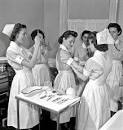Prior to 1975 teaching hospitals accepted applications from high school academic graduates who were interested in studying nursing. Nursing students generally studied for three years, living on the hospital site, acquiring confidence and competence regarding a broad range of patient care before writing their provincial RN (Registered Nurse) exams. Scoring a pass in the RN exams meant that they were RNs.
Relocating from family to residence helped those young people, most of whom were girls, decide quickly if nursing was the vocation they wanted. If they didn’t like the idea of getting their hands soiled or adhering to a strict curfew, they left for greener pastures within a few months.
In large teaching hospitals a September class might number more than 100 enthusiastic students. If that hospital had a January class, another 35-40 students would join. Considering the course was three years long, some hospitals had more than 400 students in residence, providing patient care on the wards, as well as taking classes. With their students’ enthusiasm, hospitals required fewer paid staff even as patient care was maintained and improved. The benefits were enormous as nursing students lived their chosen profession.
In 1975, hospital schools for nursing students became extinct. High school students who wished to become professional registered nurses were required to complete a university degree. The cost of tuition, texts, transport, and food and lodging was high. At the same time, opportunities for interaction with patients and learning on site were severely limited. The result was that many university-educated graduates completed the four-year degree only to discover they didn’t like nursing.
Today, fewer nurses do hands-on patient care in general hospitals. It’s too expensive: staff with less knowledge and experience are responsible for many duties that were a nurse’s in the past. This way, the hospital saves money.
One of the best and simplest ways a nurse used to assess her patient was to bathe that patient. It took about ten minutes. During that time, respiration, skin colour and turgor, independent body movement, muscle tone, etc. was noted. The patient told the nurse his/her worries, home situation, those things, pets and people he/she trusted as well as future plans. That ten-minute-period built trust between the patient and staff: trust that may have had a positive effect on healing.
But we don’t do things like that anymore.
Touch may be interpreted as sexual. There are too few staff, or they are too busy. We can always find an excuse.
Nursing is a profession that suffers constant putdowns. One lawyer said it was a ghetto. Someone called nurses “Gophers” — Go for this, Go for that. Although it’s not a job for which you wear your finest party dress, it is a wonderful way to love you, and to show your love through your finely honed skills and a smile.
Nursing has changed. It has not improved regarding care to those who need care more than tubes.
We made a poor decision moving nursing students to universities. We learned more living the job twenty-four hours a day.
Submitted by J Alexander

